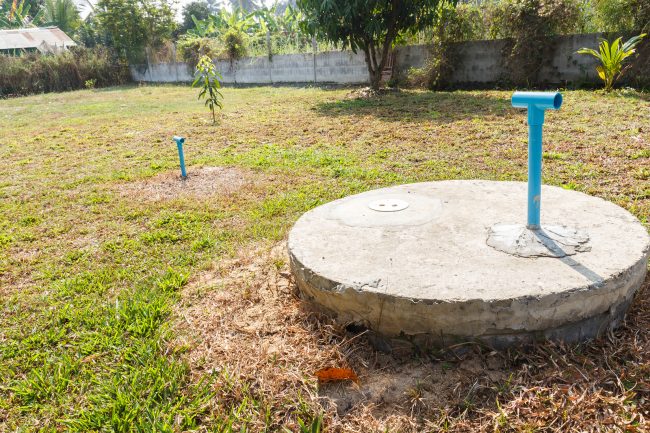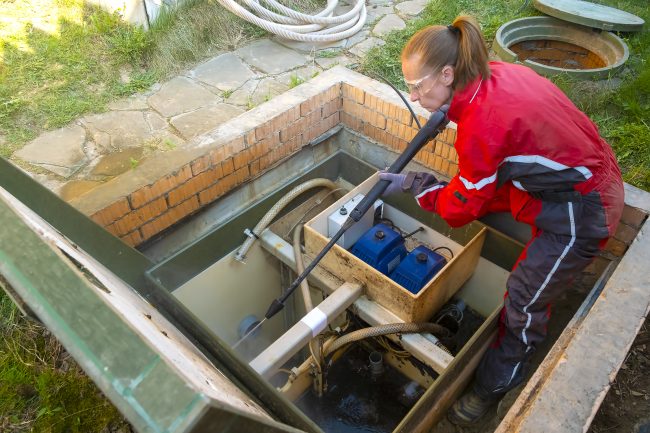Sewage System Maintenance
Program Contacts
Megan Conklin REHS
Supervisor
216.201.2001 ext 1266
mconklin@ccbh.net
Rebecca Jewell REHS
Program Manager
216.201.2001 ext 1246
rjewell@ccbh.net
Although it may be buried underground and easily forgotten, your household sewage system performs a vital task. It is responsible for receiving, treating, and disposing of all the household wastewater you generate each and every day – every washer load, shower, and flush. But just like a furnace or roof, it should not be taken for granted and will not last forever.
Even though sewage systems thrive on wastewater, certain chemicals can harm the delicate balance in a septic tank and should not be run through the system:
- Chlorine bleach
- Drain cleaners
- Floor wax
- Kerosene and gasoline
- Motor oil
- Nail polish remover
- Paints and solvents
- Thinners
Other materials may not chemically harm the system, but may cause a blockage or clog pipes. These items will not break down and cannot be digested by microorganisms:
- Animal fat
- Cigarettes
- Coffee grounds
- Condoms
- Cotton balls and cotton swabs
- Grease and cooking oil
- Plastics
- Tampons
Cleaning the Septic Tank
Having your septic tank(s) pumped on a routine basis is also an essential part of maintaining your system in good working order. Materials like sludge and grease will accumulate in the septic tank and must be removed regularly before they impact your filter bed, leach field, evapo-transpiration field, or aeration system.
Your septic tank(s) should be pumped out at least once every three years. If your family consists of four or more people or you utilize a garbage disposal, you probably need to have your tank pumped more often.
The access lids for your septic tank must be kept up to grade. This allows the tank to be easily located, pumped, and inspected. If your tank is not to grade, an extension riser should be installed at the time of your next scheduled tank cleaning.
Warning Signs of a Problem
Warning signs of an ailing sewage system can be either very subtle or quite obvious. A strong sewage odor may be noticeable in your drains or out in the yard. The grass around the system may stay unusually wet and spongy. Gray or black sewage may even be evident on the surface of the ground causing an obvious public health concern.
Partially blocked pipes may cause toilets, showers, and sinks to drain sluggishly. A pipe which is completely blocked, damaged, or even collapsed will result in a back-up in the kitchen, bathroom, or basement and may possibly even cause extensive damage to the home.
Systems designed to discharge may not exhibit obvious signs of failure. If they discharge to an underground collector pipe or storm sewer, the improperly treated sewage and resulting odors may not be noticeable to the homeowner.
This unfortunately helps support the “out of sight – out of mind” mentality that many homeowners have pertaining to their household sewage systems. The poor quality of effluent leaving the sewage system flows from the storm sewer or roadside ditch, to a stream or river, and out to Lake Erie.
Some sewage systems discharge to the surface of the ground, to swales, or to roadside ditches. The discharge area should be observed regularly for signs of system failure. Solids loss and a strong sewage odor are obvious signs of a system failure.
Protecting Your Investment
Do not build anything over or within ten feet of any part of your sewage system. This includes driveways, fences, swimming pools, sheds, decks, and house additions.
Do not allow anyone to drive heavy vehicles like cars or trucks over any portion of the sewage system. Pipes and tanks may be damaged or crushed. The soil in the filtration area may be compacted, which could minimize its ability to filter and absorb sewage.
Do not plant any trees or shrubs with complex root systems, like willows or soft maples, near any portion of the system. Their roots will grow quickly and travel significant distances laterally underground. As they seek water, they will grow into pipes causing blockages.
Sewage System Myths & Facts
Myth: “My system is working great! I never have a back-up or an odor in my home.”
Fact: Usually, a back-up occurs in the home due to a blockage in the sewer line. Just because a system does not back-up does not ensure that the effluent being discharged to the environment is being properly treated and meets water quality requirements.
Myth: “My system is in great shape because I get the tank pumped on a routine basis. The sewage pumper said that everything looked great.”
Fact: Having your septic tank pumped is an important aspect of maintaining your system. The sewage hauler cleans the tank and will usually advise you of the condition of the tank. The hauler can not tell the condition of the rest of your sewage system by only looking into the tank. The best way of determining the condition of the secondary treatment portion of the system is to have it evaluated by the Board of Health.
Myth: “I use septic system additives to help my system work better.”
Fact: A household sewage system does not require any type of additive during its normal operating life. Studies have shown that additives have not been proven to significantly aid the operation of a properly functioning sewage system and in fact may even hinder the process.
Myth: “I have a leaching system. I don’t see any sewage being discharged on my property so I’m sure it is working fine.”
Fact: Because of the severe soils in much of our county, most people actually have some form of discharging sewage system and not a conventional leaching system. These older systems are often filter bed systems that do discharge an effluent to the environment. Because the actual discharge may be occurring on another property or into a pipe underground, homeowners have a false sense of security that their sewage system is operating properly to treat the wastewater they generate each and every day.





